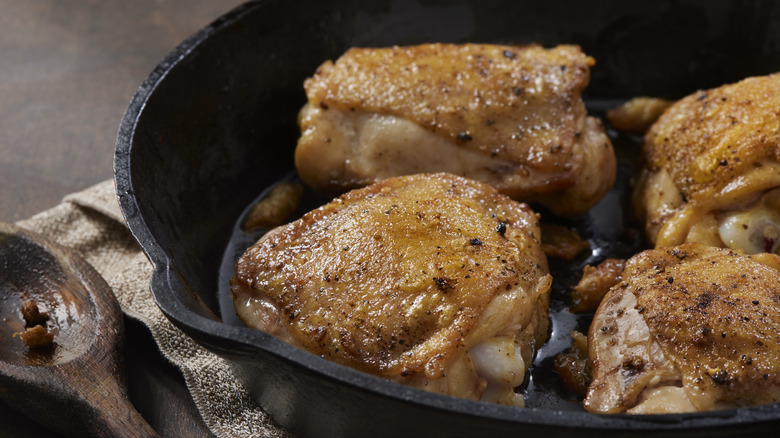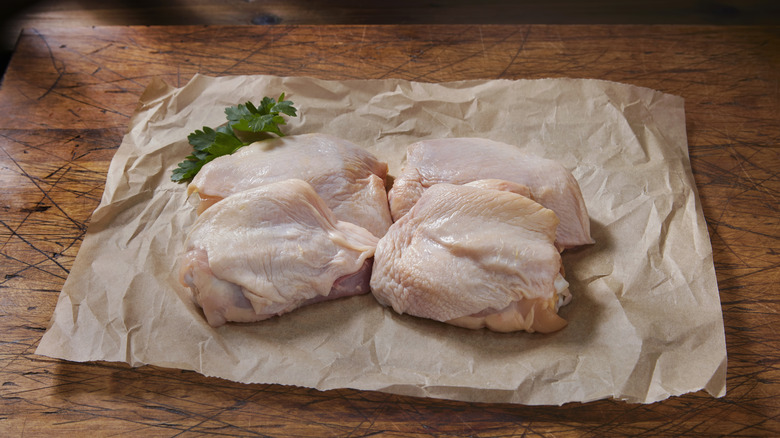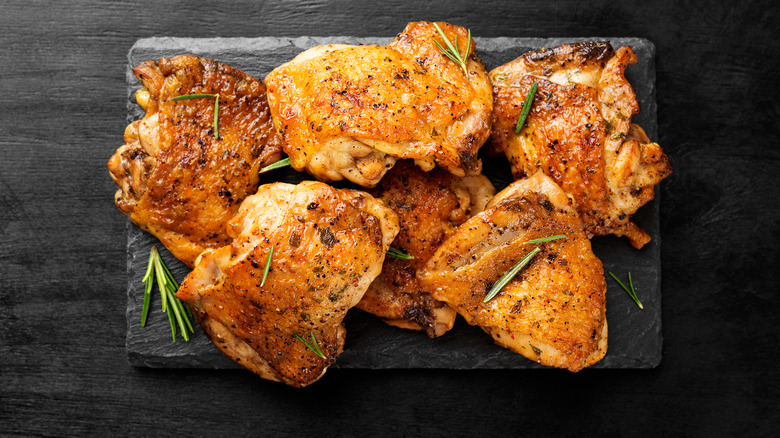The Cut Of Meat That Actually Tastes Better When You Overcook It
One of the most important principles in cooking is making sure you don't overcook your meat. There's nothing worse than wasting money on some expensive steaks or, even worse, serving a dry Thanksgiving turkey. The rules for overcooking meat aren't universal, however. In fact, there are plenty of cuts that get better the longer you cook them. You might already know that long, slow cooking is the way to make the best ribs, brisket, and lamb shanks, but you might not have heard that chicken thighs are also better the longer they're cooked.
Chicken is one of the biggest reasons why any chef owns a meat thermometer. If you undercook it you run the risk of spreading foodborne illness, but if you overcook the white meat your chicken will come out dry and chewy. Thighs, on the other hand, have more in common with pork shoulder and beef short ribs: they all have lots of connective tissue. In fact, the more you cook chicken thighs (up to a point), the better they get because that connective tissue dissolves, leaving behind fork-tender meat. So if you've got a batch of chicken thighs for dinner, it's not only okay to overcook them, it's encouraged.
Cook chicken thighs slowly
The nice thing about chicken thighs is that they're one of the least expensive cuts of chicken. Whereas boneless, skinless chicken breasts can cost $5 a pound, you can pick up things for around half the price. Just because they're cheap and don't mind a little extra heat does not mean there are no rules when it comes to cooking chicken thighs, however. The key is to go low and slow.
If you want to perfectly "overcook" your chicken thighs, go for gentle, moderate heat so that all of the connective tissue has time to break down into gelatin. The slow process will make the meat tender and the flavors will be rich (especially if you season your chicken thighs under the skin). Braising thighs in the oven using a dutch oven or on the counter in a slow cooker is easy and you can just set a timer and forget them for a while. You can also grill thighs — just cook them on the cooler area of the grill and let them slowly come up to temperature for the best results. If it's not grilling weather outside, you can also slow-roast them in the oven. Just don't cook thighs on high heat because you'll only burn the outside without fully cooking the inside.
You still need to use a thermometer
There's a big difference between a perfectly overcooked chicken thigh and one that's just plain overcooked, so while you don't have to be as fastidious about pulling your thighs off the heat as you would with chicken breast, you'll still need to keep your meat thermometer handy. The sweet spot for chicken thighs is between 175 and 195 degrees Fahrenheit, which is a little higher than the 165 degrees recommended for white meat. If dark meat is cooked to more than 210 degrees Fahrenheit it will start to dry out and get stringy.
To get the most accurate temperature reading on your thigh, all you need to do is insert your meat thermometer into the thickest section. Sometimes when you're making thighs, it can be hard to see which part is the thickest, so slide the probe of the thermometer in through the side and towards the center. If you hit the bone, pull it back out about a centimeter and give the instrument a few seconds to settle on a temperature. It's also a good idea to take a reading from at least one more spot on the thigh in case there are cold spots and be sure to check each thigh if you're making more than one.


